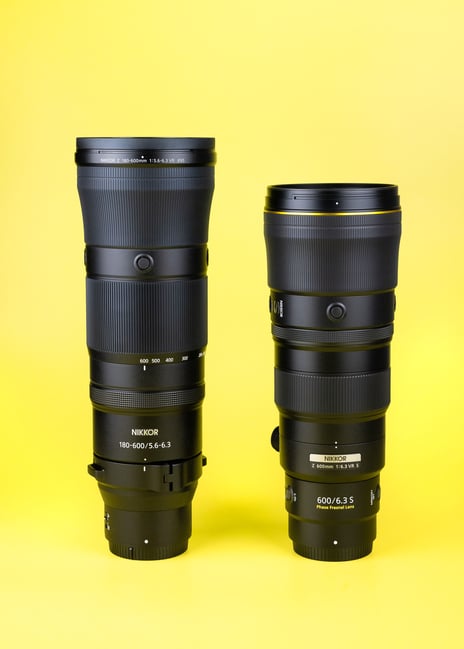Introduction
The Nikon Z 600mm f/6.3 VR S is a lightweight, supertelephoto prime lens aimed at sports and wildlife photographers who need a significant amount of reach. Featuring a Phase Fresnel element, the lens is the lightest in its class, weighing under 1.5 kg. It is slightly heavier than its Nikon Z 400mm f/4.5 VR S counterpart, but noticeably lighter than the Nikon Z 800mm f/6.3 PF VR S or any of Nikon’s exotic super-telephoto lenses.
For photographers who need even more reach, the Nikon Z 600mm f/6.3 VR S is compatible with both Nikon Z TC 1.4x and TC 2.0x teleconverters. In today’s hands-on review, we will take a closer look at the lens, discuss its optical characteristics, and compare it to other popular lens choices for the Nikon Z mount.

Design and Construction
When I first got my hands on the box containing the Nikon Z 600mm f/6.3, it felt almost empty. The impression of incredible lightness is the first thing that strikes you about this telephoto lens. Even if the 600mm f/6.3 had nothing else to offer, this is the one feature that would make you love it. If you’ve ever carried the heft of a lens like the 400mm f/2.8 G in the field, you’ll know what I’m talking about.
The current lightweight champion, the Nikon 500mm f/5.6E PF ED VR, is about 10g lighter at 1.46kg (3.21 lbs). However, its focal length is 100mm shorter, and you need to attach the FTZ adapter (125g) to use it with Z-mount cameras, so I think it’s clear which lens wins this round. I would argue that this is Nikon’s current champion among its lightweight supertelephoto lenses.

The low weight of the Z 600mm f/6.3 is due in part to the unusual optical element used in the optical design – the so-called “Phase Fresnel” element. Along with the F-mount 500mm f/5.6E PF, F-mount 300mm f/4E PF, and Nikon Z 800mm f/6.3 VR S, they form a group of only four Nikon lenses so far that use this technology.
No zoom lens has yet adopted Phase Fresnel elements, and that includes the Nikon Z 180-600mm f/5.6-6.3. How does this zoom with conventional optical elements compare? It weighs in at 2.14 kg (4.71 lbs), which is undoubtedly still “hand-holdable,” but it’s almost 1.5 times heavier than the 600mm prime (1.47 kg / 3.24 lbs). This is a noticeable difference at the end of the day.
The physical dimensions of the prime lens are also pleasing. The length of the Nikon Z 600mm f/6.3 PF is 278 mm (10.9 inches). That’s 38 mm (1.5 inches) less than the 180-600mm f/5.6-6.3. Here’s how they compare:

This difference may seem negligible. However, when you look inside my camera bag with the 600mm f/6.3 prime, it’s clear that we are already pushing things. Had I used the 180-600mm f/5.6-6.3 instead, I would have needed to put the lens hood on in reverse, necessitating a lens cap to protect the front element, which then adds to my setup time… nothing essential, but still, speed can matter a lot in wildlife photography.

Anyway, let’s take the lenses off the scales now and look more closely at their other features of their design.
The Nikon Z 600mm f/6.3 PF is an S-class lens with a nice gold ring. Lenses like this are a showcase of what Nikon is currently capable of. No expense has been spared – and a similarly generous approach is expected from a potential customer! The $4800 price tag is almost in exotic territory.
In addition to the aforementioned PF element, which is not cheap to make, the Z 600mm f/6.3 also received a full set of programmable buttons. Compared to the 180-600mm f/5.6-6.3, the 600mm f/6.3 adds an extra function button and a dedicated Memory Set button. No longer do you need to assign one of your camera’s custom buttons to the task of recalling your focus position!

The Nikon Z 600mm f/6.3 S does, however, lack two options compared to Nikon’s most exotic supertelephotos. First is the lack of a built-in teleconverter, which isn’t surprising for a lightweight f/6.3 lens. Second is that the Z 600mm f/6.3 S has both a focus ring and a control ring, but there is no Function ring (which is used for setting and recalling focus distances more quickly). I consider this a “nice to have” feature, but nothing essential, and it is only found on Nikon’s most exotic $10,000+ supertelephotos so far.
Here are the buttons and controls of the Nikon Z 600mm f/6.3 S. Keep in mind that the L-Fn2 button is repeated three additional times: above, below, and on the right-hand side of the lens.


Specifications
Below are the key specifications of the lens:
- Full Name: Nikon NIKKOR Z 600mm f/6.3 VR S
- Focal Length: 600mm prime
- Angle of View: 4°10′ (2°40′ on DX)
- Maximum Aperture: f/6.3
- Minimum Aperture: f/32
- Lens Elements: 21
- Lens Element Groups: 14
- Filter Thread Size: 95mm
- Maximum Magnification: 0.15x (1:6.7)
- Minimum Focusing Distance: 4.0 meters (13.1 feet)
- Image Stabilization: Yes
- Aperture Blades: 9
- Nano Crystal Coating: Yes
- ED Glass Elements: 2
- Phase Fresnel Elements: 1
- Aspherical Elements: 0
- Short-Wavelength Refractive Elements: 1
- Fluorine Coated Front Element: Yes
- Teleconverter Compatibility: Yes (with both Nikon TCs)
- Focus Motor: Stepping motor
- Internal Focusing: Yes
- Rings: Focus and custom
- Function Buttons: Fn1 and four duplicating Fn2 buttons
- Switches: A-M switch and distance limiter (10m to infinity)
- Dimensions (Length x Diameter): 278 x 107 mm (11.0 x 4.2 inches)
- Weight: 1470 g / 3.24 lbs (1390 g / 3.06 lbs without tripod collar)
- MSRP: $4799.95 (Check current price)

The next page of this review covers the optical characteristics of the Nikon Z 600mm f/6.3 PF, including focusing performance and sharpness tests in the lab. So, click the menu below to go to “Optical Features”:
Table of Contents